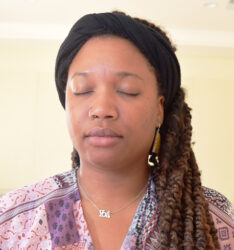Consciousness in Poetry and Prose

This space is always here.
This is what is present
right now
always.
I am this eternal space
not what appears
in it
no matter what appears.
--No Poemby Sasha Kamini Parmasad
This poem by writer and professor Sasha Kamini Parmasad gives us a delightful description of an experience that, though at first it may seem abstract and distant from us, is well within the reach of all of us. In this article I want to explore that experience with you and its immense value far beyond the beauty of its expression.
Experiences are an interesting phenomenon. By definition they appear abstract and elusive until shared by the listener! For example, just imagine for a moment that you have never tasted a strawberry. I can tell you it is sweet and juicy with a slightly pitted texture. But that means little really until you take your first bite and exclaim, “Oh, I see what you mean.” The other aspect of experience is that it is subjective: each one of us can have a different experience of the same thing. We bring our own make-up to the experience. We may describe the experience differently than someone else depending on how it strikes us.
I happen to know Sasha, the award-winning writer who composed this short poem. I also happen to know that she practices the Transcendental Meditation technique and has for some time. From this I know that what she is describing is an experience of the transcendent. What is transcending, you may ask. It is an experience that can occur when, through the regular practice of Transcendental Meditation, the mind settles to quieter and quieter levels of its own activity and then simply goes beyond all mental activity whatsoever to a field of Being, beyond thought—the transcendent. This is the experience of what we call the source of thought.
This experience of the source of thought, of transcending thought, has been enjoyed over the past 50 plus years by many people around the world from all different backgrounds and cultures who regularly practice the Transcendental Meditation program. At first the experience can be hazy or vague. Some people will say “I am not sure what that was, was I asleep, I don’t think so, but I wasn’t thinking.” Over time, with twice daily regular meditation, we find that the experience becomes clearer and more mature. In fact, as practice continues through time, with the alternation of TM and one’s normal daily life, it turns out the nervous system can become so familiar with the experience that the experience of this transcendent, unbounded, deeply rested, all expanded state is never lost even when one is awake, asleep or dreaming. It infuses the nervous system and is integrated into our ongoing experience. The silent source of one’s thought, the silent basis of one’s self is always there as the underlying experience no matter what else may be happening.
As we have said, in this experience the experiencer is beyond the boundaries of thought; beyond any boundaries at all, beyond even the boundaries of space and time. In the experience of one who has a matured level of this experience it could be described as being in the space that “is always here.” One could have the sense of it “always” being “what is present.” And since this is, by definition, an experience beyond boundaries, then one feels totally unbounded (again, no sense of space or time) and may express it as “I am this eternal space.”
States of consciousness
This is an experience of a developing state of consciousness, of expanding human awareness. We are all familiar actually with experiencing different states of consciousness. As you read this article, you are in one right now. As I write for you, I too am in that state. We call it waking state of consciousness. When we go to bed later today, we will fall into sleeping state of consciousness and then dream state.
Every state of consciousness has a specific style of experience. When we are awake, we look around and experience the objects and circumstances that surround our lives. When asleep, we have no experience. In dream state, we have an illusory style of experience. These then are three different states of consciousness, with three unique styles of experience. It also turns out these distinct states of consciousness are supported by three different styles of physiological functioning. Our experiences are dependent upon how our bodies (and our brains) are functioning.
In waking state, the body is characterized by the most activity.
In dream state of consciousness, the body is characterized by some activity.
In deep sleep, the body is characterized by deep rest.
Scientific researchers who have been looking at the experience of transcendental consciousness for more than 40 years have concluded that scientifically it is a fourth major state of consciousness. That is, it has its own style of experience, and is accompanied by a distinct style of functioning in the nervous system. Specifically, the body is in an extremely deep state of rest, with low respiration rates, low heart rate, low stress-related hormones, increased hormones that support a sense of wellbeing, and so forth. At the same time, the functioning of the brain is uniquely holistic and orderly, or coherent, and the mind is deeply resting and yet alert. There are over 360 published studies showing the changes that occur in mind, body and behavior that are a direct result of the experience of transcending—and they are well worth investigating.
In fact, the practical benefits in daily life (improved health, more clarity of mind, a calmer more settled sense of wellbeing, and an increasing ability to conduct life as one would wish to do) are the reason that systematically enlivening the experience of transcending through practice of the TM technique is such a valuable and desirable pursuit.
As we have been discussing, the experience of transcendence is an experience of a fourth state of consciousness; so far we have more than likely just been experiencing the more commonly encountered states of waking, dreaming, and sleeping. Transcendental consciousness is totally a simple, natural and easy experience to develop. Our brains and nervous system are already capable of enjoying it—we just need some instruction and practice of TM to fulfill our inherent capability to experience it.
We have also said that as the experience matures, our nervous system is so constructed that it can maintain the experience of transcendence along with whatever else we are experiencing—along with waking, sleeping and dreaming. The value of this experience is that we are always totally stable within ourselves, ready to respond appropriately to whatever comes our way, to excel in whatever way we want to, but all without gaining any stress to the nervous system because we are now so healthy, flexible and adaptable. This experience indicates that we have all our resources totally available to us to enjoy life to the fullest—to live the full potential of life.
The state of full potential is the realization of our true, fundamental being or self. In this state, we would know our true self to be consciousness and “not what appears in it.” Before the stabilization of this experience, our tendency was to identify with what we were experiencing external to ourselves and to internalize that. One spontaneously identified with the ever changing external phenomena of our lives—as a single or married woman, a student, a mother, a professional, a happy or sad person, etc.
This poem by Sasha Parmasad simply and profoundly articulates that our transcendental value of unbounded, expanded consciousness is constant and consistent. Nothing replaces it, no matter what it might be, “no matter what appears.”
Transcendence is a natural part of life. It is there for all of us to develop within ourselves so that we can easily and naturally live the fullest value of life. This poem is a beautiful reminder of that fact.
About the Author
Lesley Goldman is the retired director of a non-profit educational organization.





